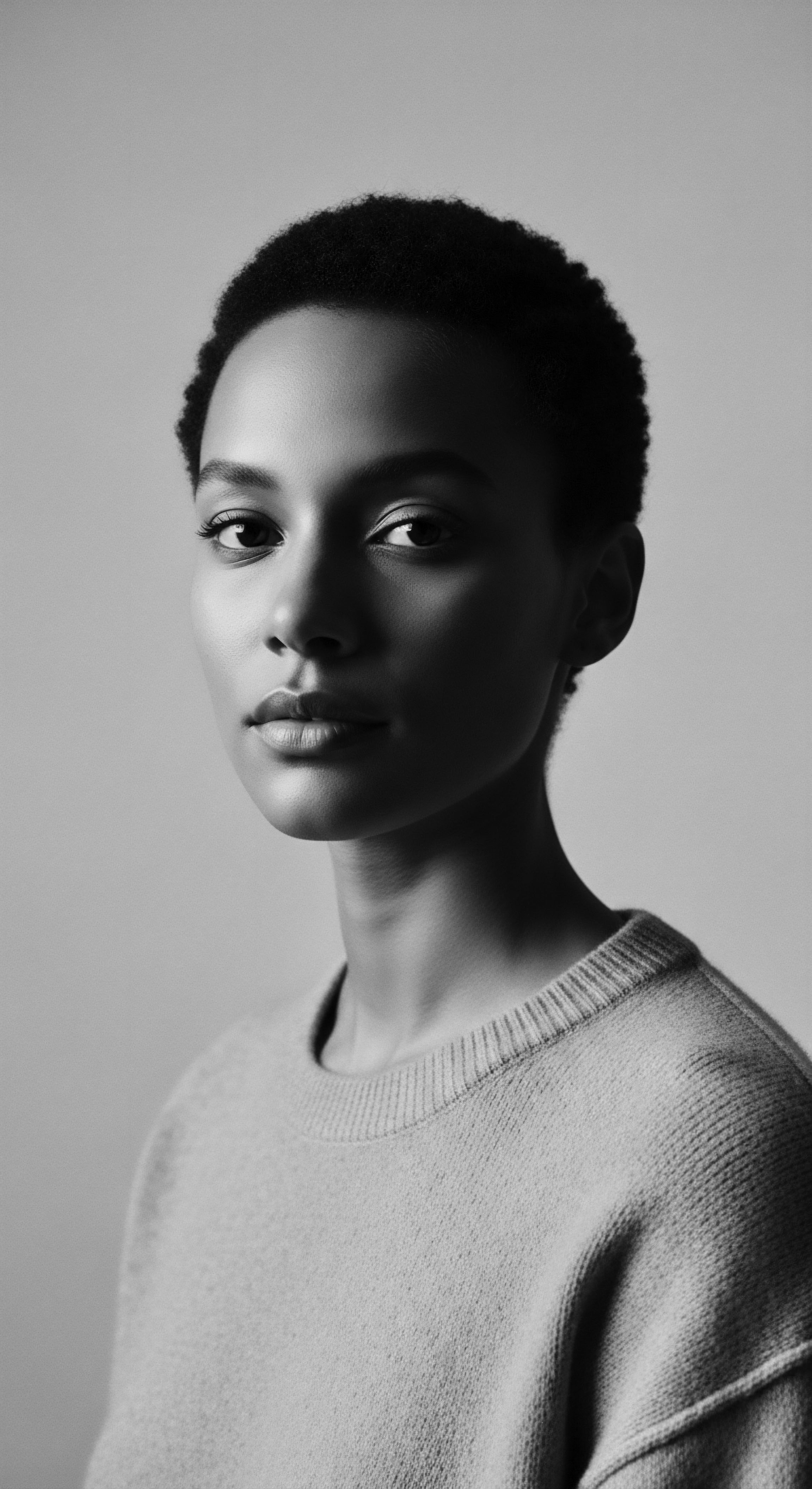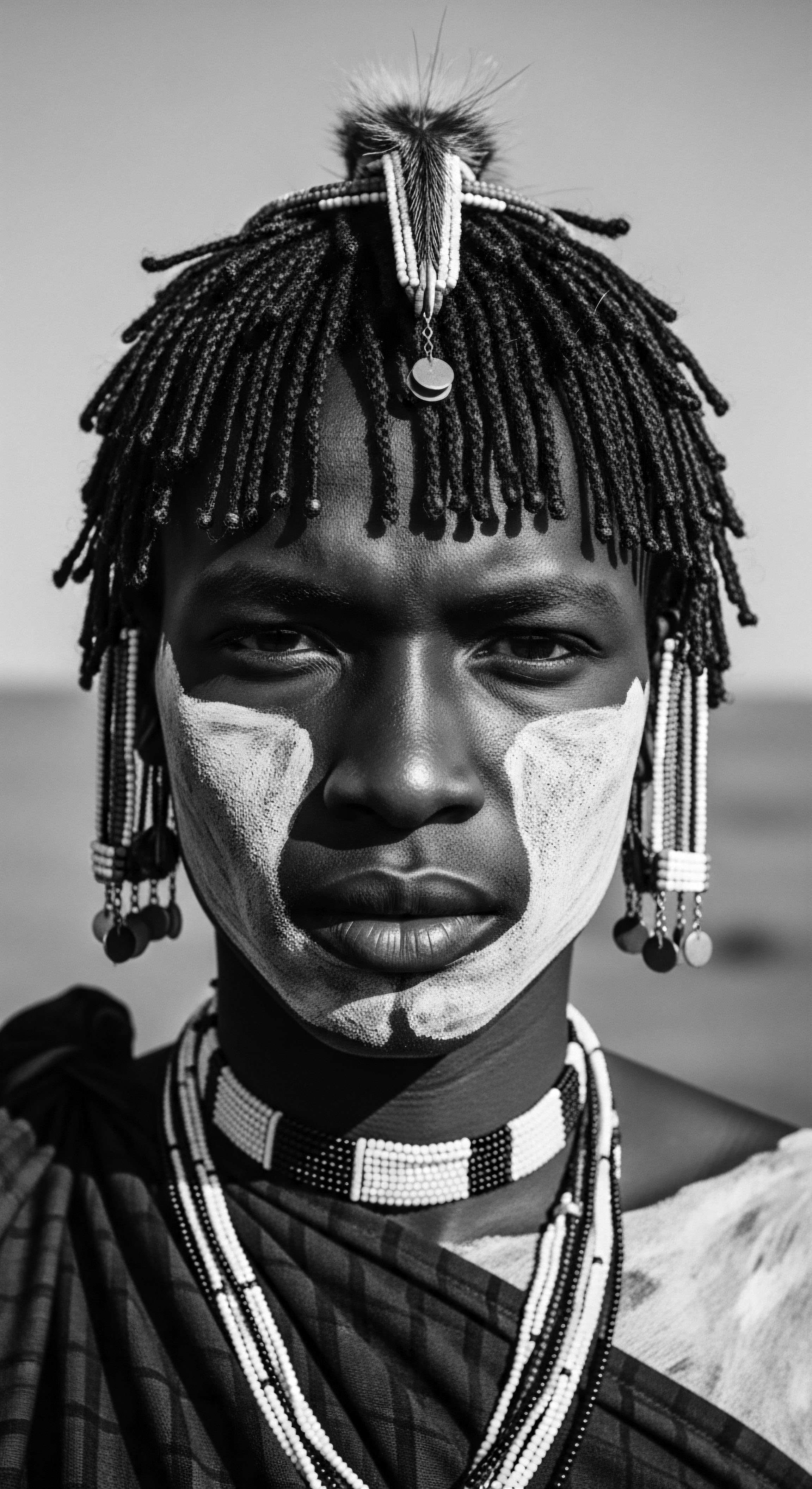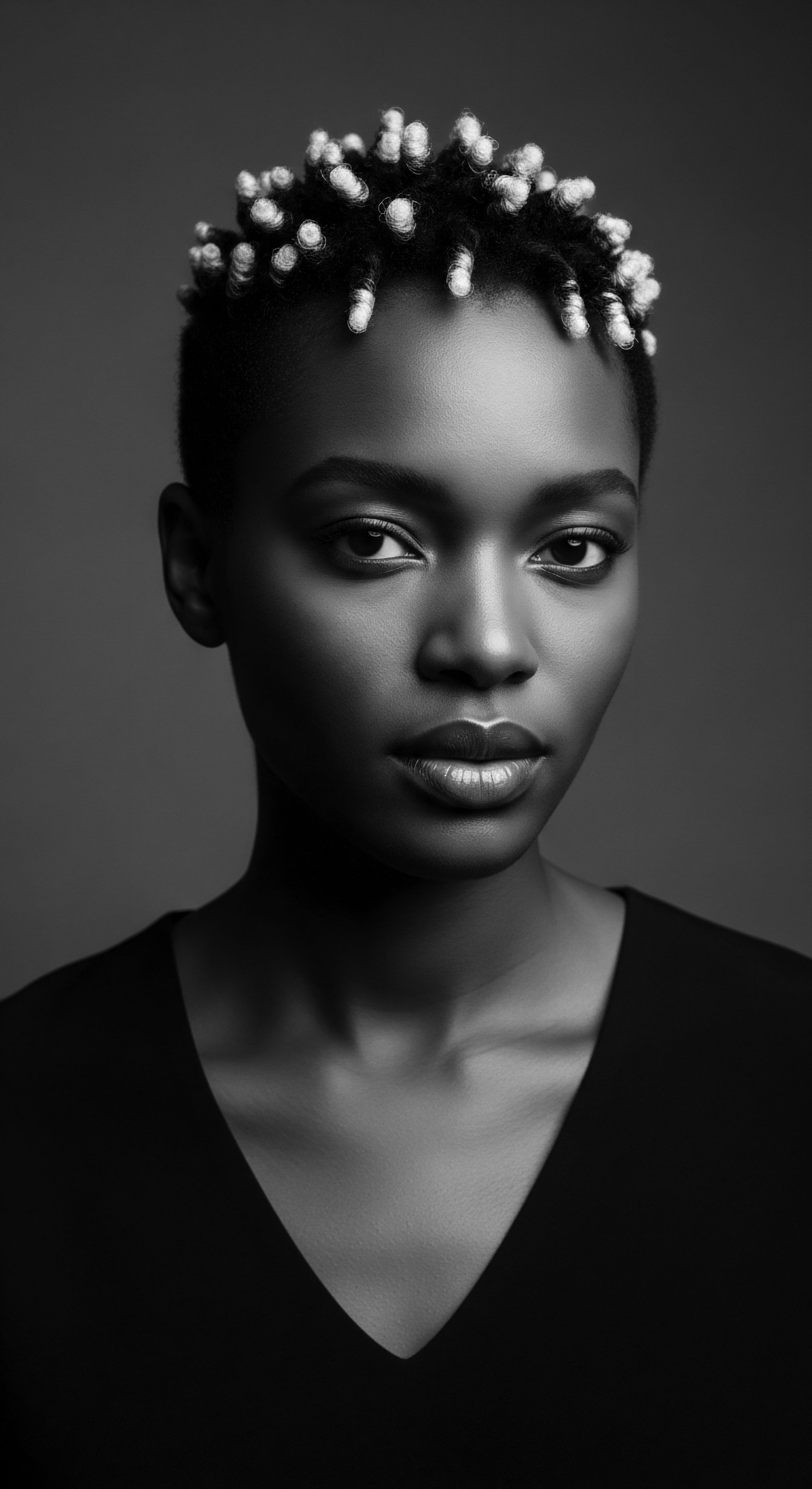
Fundamentals
The concept of Black Appearance reaches far beyond simple observation; it encompasses the multifaceted visual markers deeply tied to individuals of African descent, particularly as expressed through the glorious contours and textures of their hair. This initial grasp of the term illuminates how external presentation forms a foundational layer of identity, resilience, and belonging within Black and mixed-race communities. The physical attributes, especially those of hair, serve as a living archive of heritage, carrying stories from ancestral lands and generations past.
Understanding this visual language begins with recognizing the unique biological properties of textured hair—its distinctive curl patterns, the ellipticity of its individual strands, and its inherent strength when cared for with intentional methods. These qualities, often misunderstood in broader societal contexts, have always been esteemed within communities where they naturally occur. The aesthetic choices made regarding hair—from intricate braids to celebratory Afros—are not merely matters of fleeting fashion; they serve as a profound statement of self, connecting individuals to a rich cultural lineage.
The Black Appearance is a living tapestry woven from the elemental biology of textured hair and the profound cultural expressions it manifests.
Across continents and centuries, hair has held exceptional weight in African societies, serving as a primary identifier. It communicated social standing, marital status, age, spiritual connections, and even tribal affiliations. The care rituals, often communal and passed down through oral traditions, reflected a deep understanding of hair’s holistic well-being, fostering a sacred bond between hair, self, and community.

The Sacredness of Strands
Long before modern cosmetology, ancestral practices viewed hair as a spiritual conduit, a literal connection to the divine and to one’s lineage. This view permeated daily life, dictating how hair was styled, adorned, and honored. Hair was never seen as inert matter; rather, it was perceived as a living extension of the self, imbued with life force and requiring reverence.
- Cultural Mapping ❉ In many West African societies, the specific configuration of hair, from ornate braids to sculpted locs, could signal a person’s clan, their ceremonial role, or even a period of mourning (Sieber & Herreman, 2000).
- Ritualistic Cleansing ❉ Traditional cleansers, often derived from local plants and herbs, were applied not just for cleanliness but for spiritual purification, ensuring both physical and energetic balance of the hair.
- Communal Bonding ❉ Hairdressing often became a collective activity, fostering intergenerational bonds as elders shared techniques and stories with younger generations, reinforcing community ties.
The very act of touching another’s hair was (and remains) a gesture of profound intimacy and trust, an acknowledgment of the spiritual and physical connection it represents. This respect for hair, deeply rooted in cultural heritage, provides a foundational understanding of the Black Appearance—a visual phenomenon that is as much about internal resonance as it is about external presentation.

Intermediate
Expanding upon our fundamental understanding, the intermediate clarification of the Black Appearance delves into its historical evolution and the societal responses it has continually evoked. The visual identity of Black individuals, particularly through their hair, has never existed in a vacuum; it has consistently intersected with historical moments, colonial impositions, and powerful movements for self-determination. This deeper grasp allows us to appreciate how practices of hair care and styling became acts of resilience, symbols of resistance, and affirmations of selfhood in the face of systemic challenges.
The textured hair of Black and mixed-race people, with its tight coils and distinct patterns, became a site of both immense cultural pride and external scrutiny. During periods of enslavement, for example, the deliberate shaving of African hair served as a tool of dehumanization, stripping individuals of their previous social markers and cultural connections. Yet, even in the most oppressive circumstances, ingenuity and ancestral memory found ways to persist, whether through hidden braided messages or the innovative use of available materials for care.
This adaptation and continuity speak volumes about the intrinsic significance of hair to identity. (Byrd & Tharps, 2001).

The Echoes of Resilience ❉ Hair as a Statement
The historical journey of Black Appearance through various diasporic experiences showcases a consistent theme ❉ hair as an unwavering declaration of identity. From the intricate coiffures of ancient African kingdoms, which denoted social status, age, and religious affiliation, to the deliberate cultivation of Afros during the Civil Rights Movement, hair has served as a canvas for cultural and political expression. The resilience of these practices speaks to a deep, inherited wisdom that recognizes hair as more than merely physical matter; it embodies spirit and lineage.
Hair serves as a powerful testament to the enduring spirit and unwavering cultural identity of Black communities through the ages.
The evolution of care rituals, too, tells a story. The passage from ancestral ingredients like natural clays and plant oils to later adaptations with limited resources during the transatlantic slave trade, and then to the rise of Black hair care entrepreneurship, reflects an unwavering dedication to nurturing these crowning glories. Each step, though sometimes fraught with external pressures to conform, also saw individuals and communities re-interpret and re-claim their hair practices as integral to their being. This journey underscores the intrinsic worth ascribed to Black hair and its profound meaning within communal and personal spheres.

A Legacy of Care ❉ Ingredients and Tools
The meticulousness involved in traditional Black hair care stemmed from a deep understanding of textured hair’s specific needs, long before scientific laboratories could analyze its unique properties. Tools and ingredients were carefully selected, often derived from the immediate natural environment, reflecting a harmonious relationship with the land and its bounties.
Consider the contrast between traditional approaches and external impositions over time:
| Aspect Core Philosophy |
| Ancestral Practices (Pre-Colonial Africa) Hair as sacred, spiritual, and social indicator. Care for vitality. |
| Impact of Colonialism/Slavery & Westernization Forced assimilation, suppression of traditional styles, emphasis on "straightening" for acceptance. |
| Modern Re-Claiming & Innovation Embracing natural textures, celebrating diversity, advocating for protective styles, holistic wellness focus. |
| Aspect Key Ingredients |
| Ancestral Practices (Pre-Colonial Africa) Shea butter, various plant oils, herbs, natural clays, ash for cleansing and moisture. |
| Impact of Colonialism/Slavery & Westernization Limited access to traditional ingredients; reliance on harsh chemical straighteners and improvised solutions. |
| Modern Re-Claiming & Innovation Resurgence of natural ingredients, scientific advancements in textured hair care, creation of specialized products. |
| Aspect Styling Tools |
| Ancestral Practices (Pre-Colonial Africa) Hand-carved combs, natural fibers for extensions, braiding implements made from natural materials. |
| Impact of Colonialism/Slavery & Westernization Introduction of hot combs, chemical relaxers, and tools designed for straight hair, leading to damage. |
| Modern Re-Claiming & Innovation Tools designed specifically for coils and curls, diverse braiding tools, detangling brushes that preserve integrity. |
| Aspect The enduring journey of Black hair care reveals a continuous thread of adaptation and self-determination, honoring inherited wisdom while navigating societal pressures. |
These contrasts underscore the continuous efforts to maintain and preserve the intrinsic worth of Black Appearance, a visual statement that communicates heritage, strength, and unwavering beauty against a backdrop of evolving societal norms.

Academic
The academic elucidation of the Black Appearance requires a rigorous investigation into its deep historical, sociological, and even biological underpinnings, transcending superficial visual assessments. This scholarly perspective frames Black Appearance not merely as a set of aesthetic traits but as a profound socio-cultural construct, intricately connected to systems of power, identity formation, and the enduring legacy of ancestral wisdom. It involves discerning the nuanced interactions between phenotypic characteristics, inherited cultural practices, and the broader societal gaze, particularly within Western contexts.
At its core, the Black Appearance serves as a significant racial signifier, second only to skin color in its immediate recognition and interpretation (Mercer, 1990). This prominence means that hair, in particular, becomes a potent site where cultural heritage, personal autonomy, and systemic pressures converge. The unique helical structure of coiled and kinky hair strands, a biological marvel offering resilience and density, simultaneously presented challenges within Eurocentric beauty standards. The historical imperative to conform to these norms, often through damaging chemical processes or painful heat treatments, represents a profound loss of connection to inherent selfhood and ancestral practices (Byrd & Tharps, 2001).

The Societal Contours of Coiled Hair
The societal interpretation of Black Appearance has been historically shaped by discriminatory attitudes that elevated Eurocentric beauty ideals as the universal standard. This imposed hierarchy rendered naturally textured hair as “unprofessional” or “unruly,” creating tangible barriers for Black individuals in educational and professional spheres. The devaluation of indigenous hair textures and styles became a tool of social control, influencing self-perception and limiting opportunities.
This external pressure often compelled individuals to alter their natural hair, a practice with deep psychological implications for identity and self-acceptance (Clarke-Jeffers et al. 2020).
Black Appearance, particularly through hair, stands as a profound symbol of resilience and cultural continuity amidst historical challenges.
Consider the legal battles fought over hair, which powerfully illustrate how personal appearance became a battleground for racial equity. The renowned case of Rogers V. American Airlines (1981) serves as a poignant example. In this landmark legal dispute, Renee Rogers, a Black flight attendant, challenged American Airlines’ grooming policy that prohibited employees from wearing cornrows, a style deeply rooted in African cultural tradition.
The court, in its ruling, upheld the airline’s policy, determining that cornrows were an “easily changed characteristic” and thus not intrinsically linked to race, therefore not falling under the protection of Title VII of the Civil Rights Act of 1964. This decision, though a legal setback at the time for advocates of natural hair rights, underscored the profound disjuncture between legal interpretation and the lived reality of Black women, for whom cornrows and similar styles hold immense cultural and historical significance.
The Rogers case, while nearly half a century in the past, illuminates the persistent struggle against systemic biases embedded within institutional norms. It demonstrated how notions of “professionalism” were, and often remain, implicitly tied to Eurocentric appearances, compelling Black women to engage in “mental gymnastics” of self-alteration to achieve professional acceptance (Daye, 2023). This historical incident and its outcome highlight a critical aspect of Black Appearance ❉ its capacity to reveal deeply ingrained prejudices and the continuous need for advocacy, leading eventually to legislative efforts like the CROWN Act, which seeks to outlaw hair discrimination.

Ancestral Wisdom Meets Modern Science ❉ A Harmonious Understanding
The understanding of Black Appearance also extends to the scientific validation of ancestral hair care practices. For centuries, traditional communities developed sophisticated methods for maintaining textured hair, relying on an intuitive knowledge of natural ingredients and mechanical manipulation that supported hair health. Modern trichology, examining the unique biological characteristics of coiled hair, often affirms the wisdom embedded in these ancient rituals. The science of hair structure, particularly the elliptical cross-section and higher cuticle count of coiled strands, explains their tendency towards dryness and their need for moisture retention and gentle handling (Byrd & Tharps, 2001).
This scientific insight provides a clear explanation for why ancestral practices, such as routine oiling, protective styling, and gentle detangling with natural combs, were not merely cosmetic choices but rather essential methods for preserving the vitality of hair. The consistent application of nourishing oils, for example, seals the cuticle, reducing moisture loss, a practice now understood through contemporary cosmetic chemistry.
The collective wisdom of Black communities across the diaspora has accumulated a vast body of knowledge regarding hair care, passed down through generations. These practices, though sometimes adapted due to resource availability or societal pressures, retain their core intention ❉ to honor the hair’s inherent characteristics and to preserve its integrity. This academic discussion of Black Appearance seeks to bridge the chasm between historical cultural practices and scientific validation, recognizing that inherited traditions often contained empirical truths awaiting modern confirmation.
- Understanding Hair Porosity ❉ Textured hair frequently exhibits high porosity, meaning its cuticles are often raised, allowing moisture to enter and exit readily. Ancestral deep conditioning treatments with ingredients like fermented rice water or specific plant masques provided vital protein and moisture, reinforcing the hair’s natural barrier.
- Scalp Health as Foundation ❉ Many traditional African hair care systems emphasized scalp massage and the use of herbal infusions to stimulate circulation and maintain a healthy scalp environment. This directly correlates with contemporary dermatological understanding of a healthy scalp as the root of hair vitality.
- Protective Styling Practices ❉ Braids, twists, and locs, originating in ancient Africa, served as a primary means of protecting delicate strands from environmental damage and reducing manipulation. This ancestral foresight aligns with modern recommendations for low-tension styles to prevent breakage and promote length retention.
The academic exploration of Black Appearance, therefore, extends beyond aesthetic critique to encompass the profound intelligence embedded within Black hair traditions. It highlights how these traditions, often dismissed by dominant beauty narratives, are rooted in a deep, experiential knowledge of textured hair’s unique biology and its intricate relationship with identity, community, and ancestral legacy.

Reflection on the Heritage of Black Appearance
To contemplate the Black Appearance is to stand at the confluence of time, tradition, and boundless spirit. It is to acknowledge a living heritage, sculpted by elemental biology and refined through centuries of cultural expression. The story of Black hair, in particular, is not merely a chronicle of styles; it stands as a testament to profound resilience, creativity, and an unyielding connection to ancestral wisdom. Each coil, every twist, and the very inclination of a strand carries echoes of ingenuity from ancient African civilizations and narratives of enduring beauty through diasporic journeys.
This enduring connection, which Roothea holds so dear, beckons us to look beyond fleeting trends and into the deep wellspring of what it means to truly honor one’s heritage. The practices passed down from generation to generation – the gentle detangling, the thoughtful application of natural emollients, the patient artistry of braiding – are not simply antiquated rituals. They embody a deep, embodied science, a holistic understanding of hair’s vitality and its sacred place within the individual and the collective. These traditions remind us that care for hair is a spiritual act, a continuation of a legacy that celebrates inherent beauty and strength.
The evolution of Black Appearance continues, marked by persistent innovation and a strengthening voice demanding recognition and respect. Yet, the foundational understanding remains tied to the indelible mark of heritage. The visual declaration made through one’s hair becomes a dialogue with the past, a vibrant statement in the present, and a guiding light for future generations. It is a harmonious celebration of identity, a visual poem of perseverance, perpetually reminding us of the soul embedded within each strand.

References
- Banks, Ingrid. Hair Matters ❉ Beauty, Power, and the Politics of Dreadlocks. New York University Press, 2000.
- Byrd, Ayana D. and Lori L. Tharps. Hair Story ❉ Untangling the Roots of Black Hair in America. St. Martin’s Griffin, 2001.
- Clarke-Jeffers, Paige, et al. ““Hair is your crown and glory” – Black women’s experiences of living with alopecia and the role of social support.” Clinical Psychology & Psychotherapy, vol. 27, no. 5, 2020, pp. 696-705.
- Daye, Shameika D. The Black Hair Experience ❉ Exploring the Workplace Experience for Black Women with Natural Hair and Hairstyles. University of Central Florida, 2023.
- Mercer, Kobena. Welcome to the Jungle ❉ New Positions in Black Cultural Studies. Routledge, 1994.
- Patton, Sharon F. African-American Art. Oxford University Press, 1998.
- Rogers v. American Airlines, Inc., 527 F. Supp. 229 (S.D.N.Y. 1981).
- Sieber, Roy, and Frank Herreman, editors. Hair in African Art and Culture. Museum for African Art, 2000.
